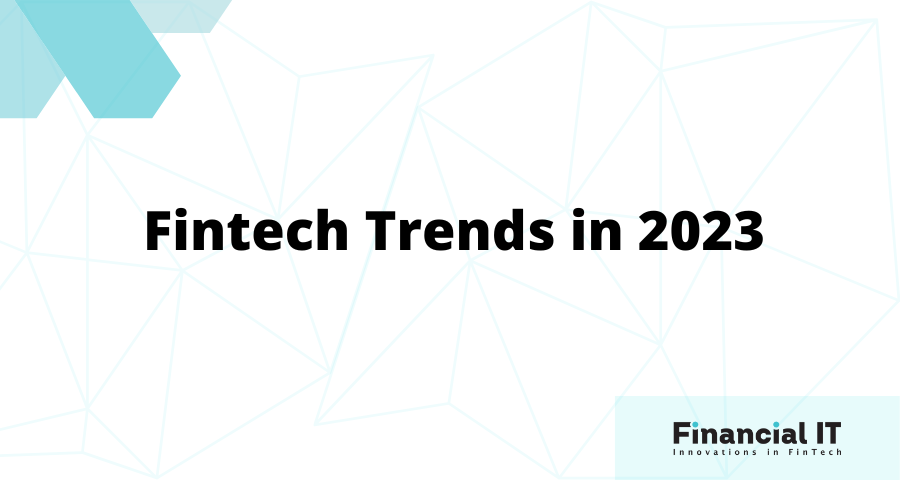Fintech trends in 2023: Banking, Payments, Blockchain, RegTech and more


Fintech has been on the rise in recent years, and with the growing need for digital solutions to manage financial services, this trend is estimated to continue through 2023. The increase in demand for digital solutions to manage financial services As a consequence of this, it is expected that the entire size of the worldwide fintech market will reach a total of $305 billion by the year 2023. This expansion can be attributed to a wide range of factors, including developments in technology, an improved acceptance of fintech products by regulatory authorities, and an increase in customer demand looking for economic solutions that are both simple and safe.
The following are some key trends expected to shape the global fintech market in 2023:
The growing demand for banking solutions: In response to the growing number of individuals relying on digital banking solutions, financial institutions are gradually investing in technology that can better meet the demands of their clientele. This involves developing chatbots powered by artificial intelligence and offering consumers access to cloud-based technologies that make it easy for them to manage their finances from anywhere. Banks are also striving towards the goal of developing more tailored services for consumers that are based on the specific requirements of each individual customer.
Growth in cross-border and contactless payments: Globally, cross-border and contactless payments are increasingly popular due to the rise of global businesses. Technology improves the speed, safety and security of international transactions. Businesses can speed up payment processing and reduce fraud. In recent years, contactless payment systems have grown in popularity, allowing customers to make secure purchases worldwide using their phones or credit cards. Due to multi-factor authentication, this payment option is user-friendly and secure. As governments embrace a global digital economy, cross-border and contactless payments will undoubtedly increase. For example, governments can regulate multinational corporations or use blockchain technology to speed up international settlements. In 2023 and beyond, cross-border and contactless payments will continue to be popular due to their security and worldwide trade possibilities.
Increased Adoption of DeFi and Blockchain technology: The use of blockchain technology has steadily increased in recent years due to the fact that it is able to reliably store data securely and carry out reliable transactions without the need for a third party to act as an intermediary. In addition, many different fintech organizations are implementing it as a means to simplify their business procedures, cut down on fraudulent activity and improve the quality of service they provide to their customers. Ripple and other blockchain-based platforms have gained traction among businesses and consumers, which is expected to lead to wider acceptance in the future. The future of DeFi protocols such as stablecoins, which increase liquidity, cost savings and stability, is exciting. Within two years, it is expected that DeFi and blockchain technology will promote innovation in various fields.
The evolution of non-bank financial technology: Non-bank financial technology companies offer a variety of products such as electronic payment services, mobile wallet services and cryptocurrency exchanges. The ease of use and relative affordability of these solutions compared to more conventional banking services have contributed to their increased popularity. When it comes to non-bank financial technology solutions, companies like PayPal are now leading the pack; however, as regulations continue to be eased, more firms are expected to enter this space over time.
The development of open banking platforms: Open banking platforms enable customers to access their financial data from a variety of sources within the framework of a single, user-friendly platform. This gives customers the opportunity to gain insight and make decisions that are more informed about their money management routines. Due to the laws put in place by the EU’s PSD2 directive, these platforms have already started making waves across Europe. Many countries are expected to follow suit soon enough thanks to greater consumer awareness of these solutions.
A better regulatory landscape: In response to an increase in consumer demand for digital solutions for financial services, regulatory agencies around the world have steadily loosened restrictions on fintech companies. This not only gives existing companies greater leeway when it comes to inventing new products or launching new services across geographical boundaries, but it also encourages new entrants into the market by providing an incentive for them to enter the market.
Built-in economy improvement: Embedded financial technology will allow consumers to access financial information and make payments and transfers seamlessly. Embedded finance will increase the speed and flexibility of digital transactions for banks, payment providers, insurance companies and other businesses. Cross-sector relationships can accelerate the development of new products by fintech companies. Open banking standards will continue to change the delivery of payments, data and financial services. Breakthroughs in AI and ML can help companies improve their operations with built-in economics. Thus, embedded finance is expected to transform our financial interactions by the end of 2023.
Overall, there is no doubt that 2023 will be an important year for the global fintech market; with increasing demand for digital banking solutions along with an improved regulatory landscape paving the way for more innovative technologies such as blockchain to be adopted on a larger scale than ever before – we can expect some exciting times ahead!













![Bitcoin [BTC] attempting another resistance breakout: Will it break $30,000 Bitcoin [BTC] attempting another resistance breakout: Will it break $30,000](https://www.cryptoproductivity.org/wp-content/uploads/2023/03/BTC-michael-AMBCrypto_bulls_running_while_bitcoin_lurks_in_the_background_cc2f6f61-f2bf-4ded-992e-7660dccb3f48-1000x600-120x120.png)











